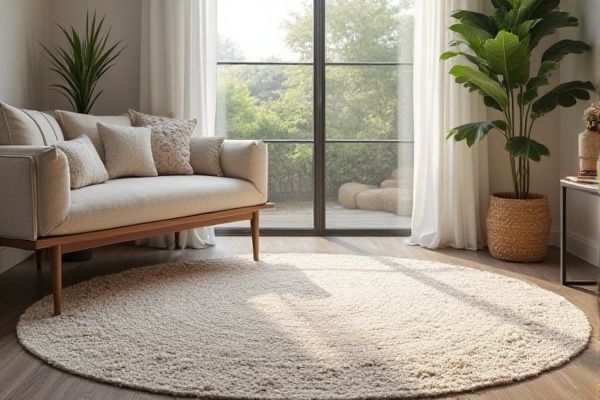
Polypropylene rugs offer superior durability and stain resistance, making them ideal for high-traffic areas and homes with pets, while cotton rugs provide a softer, more natural feel and are easier to clean but less resilient to wear and moisture. Explore the detailed comparison to determine which rug best suits your lifestyle and interior needs.
Table of Comparison
| Feature | Polypropylene Rug | Cotton Rug |
|---|---|---|
| Material | Synthetic polymer | Natural fiber |
| Durability | High, resistant to wear and stains | Moderate, prone to wear and fading |
| Moisture Resistance | Water-resistant, quick drying | Absorbs moisture, slower to dry |
| Maintenance | Easy to clean with mild soap and water | Requires frequent washing, may shrink |
| Allergen Potential | Low, hypoallergenic | Higher, can trap allergens |
| Eco-Friendliness | Less biodegradable, made from petroleum | Biodegradable, sustainable natural resource |
| Cost | Generally affordable | Varies, often higher priced |
| Comfort | Less soft, synthetic feel | Soft, breathable texture |
| Use Case | Ideal for high traffic and outdoor areas | Best for low traffic, indoor use |
Introduction to Polypropylene and Cotton Rugs
Polypropylene rugs are made from synthetic fibers known for their durability, stain resistance, and affordability, making them ideal for high-traffic areas and outdoor use. Cotton rugs, crafted from natural fibers, offer softness, breathability, and eco-friendliness, but they may require more maintenance and are less resistant to wear and moisture. Choosing between polypropylene and cotton rugs depends on factors like intended use, budget, and preferred texture.
Material Composition and Manufacturing
Polypropylene rugs are made from synthetic polymers derived from petroleum, created through a process called polymerization that produces durable, stain-resistant fibers ideal for high-traffic areas. Cotton rugs consist of natural cellulose fibers harvested from the cotton plant, woven or tufted using traditional textile manufacturing methods that emphasize softness and breathability. The manufacturing of polypropylene rugs often involves machine weaving or tufting with heat-setting to enhance fiber resilience, while cotton rugs are typically handwoven or mechanically woven, emphasizing eco-friendliness and natural texture.
Durability and Lifespan Comparison
Polypropylene rugs offer superior durability and resistance to stains, moisture, and fading, making them ideal for high-traffic areas and long-term use. Cotton rugs, while softer and more breathable, tend to wear out faster and are more susceptible to stains and mold, reducing their overall lifespan. Choosing a polypropylene rug enhances Your space with a longer-lasting, low-maintenance flooring option.
Stain Resistance and Cleaning Requirements
Polypropylene rugs offer superior stain resistance due to their synthetic fibers, making spills easier to clean without absorbing liquids quickly. Cotton rugs tend to absorb stains more readily and often require more frequent deep cleaning or professional care to maintain their appearance. Choosing a polypropylene rug can save you time and effort in cleaning, especially in high-traffic or spill-prone areas in your home.
Comfort and Texture Differences
Polypropylene rugs offer a smooth, synthetic texture that is durable and stain-resistant but generally less soft compared to cotton rugs, which provide a natural, plush feel ideal for barefoot comfort. Cotton rugs excel in breathability and absorbency, enhancing softness and making them more suitable for cozy living spaces. While polypropylene rugs are easier to clean and maintain, cotton rugs deliver superior tactile warmth and a natural, breathable surface.
Indoor vs. Outdoor Suitability
Polypropylene rugs excel in outdoor settings due to their water resistance, UV protection, and durability against mildew and fading, making them ideal for patios and high-moisture areas. Cotton rugs, while soft and breathable, are better suited for indoor environments as they absorb moisture and can deteriorate quickly when exposed to outdoor elements. Choosing a polypropylene rug ensures longevity and easy maintenance for your outdoor spaces, whereas cotton rugs enhance comfort and style indoors.
Environmental Impact and Sustainability
Polypropylene rugs have a lower environmental impact during production due to the use of synthetic materials that require less water and energy compared to cotton cultivation, which demands significant water and pesticide use. However, polypropylene is non-biodegradable and derived from fossil fuels, leading to long-term sustainability concerns, whereas cotton rugs are biodegradable and renewable but may contribute to soil degradation and high water consumption. Your choice between these rugs should balance immediate production efficiency against long-term environmental sustainability.
Cost and Budget Considerations
Polypropylene rugs are generally more budget-friendly than cotton rugs due to their synthetic fiber composition, making them a popular choice for cost-conscious buyers. Cotton rugs tend to be pricier because of their natural material and higher production costs, but they offer softness and breathability that many find worth the investment. When planning your purchase, consider that polypropylene rugs provide durability and stain resistance at a lower price, while cotton rugs may require a larger budget for their natural appeal and comfort.
Design, Color, and Style Options
Polypropylene rugs offer a wide range of vibrant colors and intricate designs, making them ideal for modern or eclectic styles due to their durability and resistance to fading. Cotton rugs provide a softer texture with more natural, muted tones and traditional patterns that complement casual, rustic, or bohemian interiors. Both materials accommodate diverse aesthetic preferences, but polypropylene excels in bold, long-lasting color retention while cotton favors breathable, artisanal craftsmanship.
Which Rug Is Best for Your Home?
Polypropylene rugs offer superior stain resistance, moisture durability, and affordability, making them ideal for high-traffic areas and homes with pets or children. Cotton rugs provide natural softness, breathability, and eco-friendliness but require more maintenance due to their susceptibility to stains and wear. Choose polypropylene for durability and practicality, while cotton suits low-traffic spaces needing comfort and sustainability.
 homyna.com
homyna.com